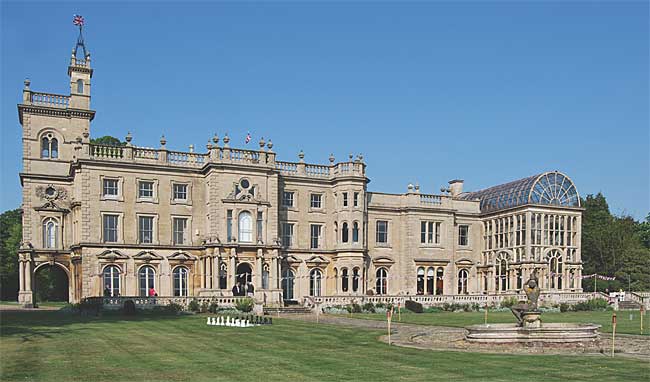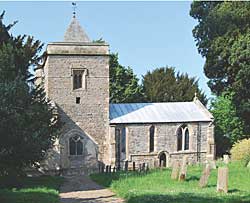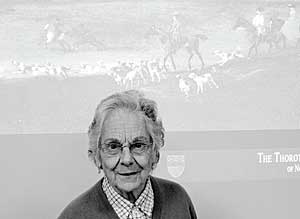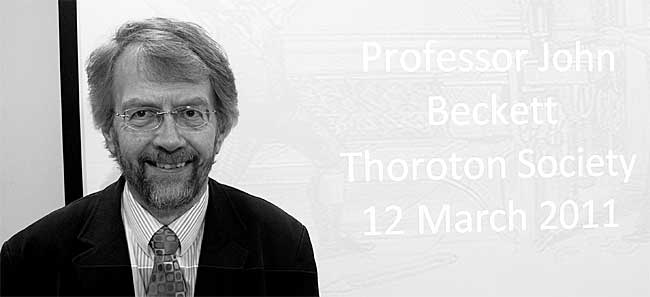Events and excursions, Spring 2011
Spring Meeting Report

Who would believe that we again had a lovely spring, verging on summer, day for our Spring meeting and AGM in Flintham on 30 April? Record numbers attended the first of our newly focused annual meetings.

We met in the church of St. Augustine, a church rebuilt in 1828 but leaving some of the medieval tower crossing.
After a welcome by our President, Dr. Rosalys Coope, the AGM was dispatched with its usual efficiency by Chairman, Professor John Beckett. Keith Goodman, long-time former Treasurer to the Society, was made a Vice-Chairman and presentations of book tokens were made to Richard Gaunt, who stepped down as Joint Editor of the Transactions and to John Hamilton, now retired Hon. Membership Secretary. Professor Beckett informed members that, arising from the survey of members, a number of the Society’s strands of work have been reassessed in a renewed focus on research and learning. John Wilson has launched a new research group and there are a number of irons in the fire as far as education and learning are concerned. All this is in addition to the work done for the Heritage Gateway by Andy Nicholson and Denise Amos. He also commended the continuing aim of keeping members informed of the Society’s activities through the excellent Newsletter and the high standards maintained by the Editors of the Transactions and he thanked all the officers for their work this year and for their continuing support.
Following the business of the AGM, Sue Clayton, the mastermind behind the day’s arrangements, gave a most interesting talk on the village and especially the church. It seems that there is a lot more to find out about ancient Flintham as Sue has a number of theories just waiting for further exploration to corroborate.
After Sue’s talk we moved to the church’s next door neighbour, the magnificent Flintham Hall, where we enjoyed a really splendid tea, taken on the terrace overlooking the parkland or in the splendid Great Exhibition inspired library – many thanks to Jacqui Elliott and her helpers from the Flintham Community Shop volunteer team for this. After tea we were formally welcomed to the Hall by Robert Hildyard, the current occupant of this wonderful Thoroton Hildyard family home, who gave us a potted history of the family and the house. We then split into groups, one to tour the village, another to visit the museum and community store, and the other to be guided round the Hall by Robert and his sister Marianne. This guided tour was a most interesting and detailed look at a house which has been lovingly cared for and filled with wonderful pictures and furniture by one family for generations.
Many who attended found that the afternoon had just disappeared and that they had missed out on the other interesting features of the village – we must go again soon to look at what this lively little parish, which strides the Fosse and runs along the banks of the Trent, has to offer.
All those who attended had a most enjoyable and fascinating visit to another of our lovely Nottinghamshire villages – we are particularly grateful to Robert and Marianne Hildyard and to Sue Clayton for making it a great Spring Meeting.
Barbara Cast
The Myles Thoroton Hildyard Lecture 12 February 2011
Rosalys Coope - Charles II Never Slept Here

Our President’s lecture was based on one room at Newstead Abbey, the so called ‘Charles II’ room, which, it has been suggested, was so named because the monarch slept in this bedroom.
Rosalys has spent many years researching Newstead and its various occupants and owners. Her extensive knowledge of the House and whole site was evident in her carefully crafted lecture. We were enthralled by her knowledge and her discussion of the room and, it has to be said, the house in general.
The talk was much more than a discussion about one particular room and gave us all a deeper understanding of the history of the house and priory which preceded it. Were we aware that some remains of the priory are incorporated into the house as it stands now? We certainly are as a result of this lecture.
The lecture was greatly enhanced by some most informative slides in a PowerPoint presentation and the audience was greatly appreciative of Rosalys’ talk as evidenced by the enthusiastic applause at the end.
The Maurice Barley Lecture 12 March 2011
John Beckett - The Luddites 200 Years On

Two hundred years ago, mechanization posed a serious threat to the status, job security and working conditions traditionally enjoyed by the artisans and craftsmen employed in the Nottinghamshire framework knitting industry. This led to serious outbreaks of machine breaking in the spring of 1811 which proceeded to encompass a wide number of towns and villages in Nottinghamshire and Derbyshire. Machine breaking or ‘Luddism’ as it came to be known in homage to the anonymous individual who provided its indispensable figurehead (Ned Ludd or Ludlam), has subsequently come to represent a defining moment in the history of labour relations, the Industrial Revolution and the making of the English working class.
In a characteristically lucid, well-informed and deeply researched lecture, the Society’s Chairman John Beckett used the bicentenary of the first incident of machine breaking (at Arnold in March 1811) to review the evidence, charting events down to the imposition of the death penalty upon machine breakers in the summer of 1812. Not the least of the interesting themes to emerge from the lecture was the extent to which the local authorities responsible for maintaining law and order (the county magistrates and the Lord Lieutenant, the 4th Duke of Newcastle) were caught off-guard and continued to exhibit a degree of insouciance which now seems remarkable. Newcastle was unsure whether to regard events as a fairly minor labour dispute, provoked by the employment of (cheaper) female labour and a necessary degree of mechanized production or as something more politically threatening. Time and again, attempts to gain information through the inducement of financial rewards proved unavailing.
By the time the movement gained a name and momentum, from the autumn of 1811, the authorities found it necessary to institute a process of local surveillance (the famous ‘watch and ward’ measures of 1812) and to protest (in vain) against the government act which made machine breaking a capital crime. Lord Byron of Newstead Abbey famously denounced the measure, immortalizing himself as a friend of the dispossessed, but Beckett was clear that interpretations of the Luddites as a ‘mob’ bent on indiscriminate riot and pillage were wide of the mark. The Luddites were disciplined, well-organised and specific in those they targeted and they punished anyone who descended to robbery or indiscriminate violence. This suggests that the Luddites had more in common with pre- than postindustrial forms of protest.
This was a timely and original lecture, delivered to an appreciative capacity crowd. One was left with two abiding impressions: first, the extent to which Luddite fears of mechanization have translated into modern challenges posed by the ubiquitous nature of the world wide web and social networking devices and, second, incredulity that this colourful, dramatic episode in the county’s history has never been subjected to the Hollywood treatment. If an enterprising producer ever decides to take up the challenge, they would do well to employ this year’s Maurice Barley lecturer as their historical adviser.
Richard A Gaunt